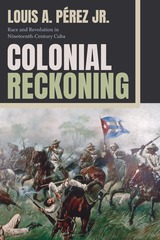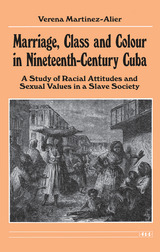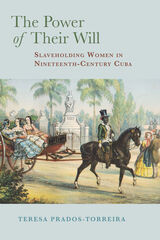3 books about Nineteenth - Century Cuba

Colonial Reckoning
Race and Revolution in Nineteenth-Century Cuba
Louis A. Pérez Jr.
Duke University Press, 2023
In Colonial Reckoning Louis A. Pérez Jr. examines Cuba’s wars for independence in the second half of the nineteenth century, focusing specifically on those Cubans who remained loyal to Spain. Drawing on newspaper articles, personal letters, military battle reports, government commissions, consular reports, literature, and other materials, Pérez shows how everyday black, white, and creole Cubans defended the Spanish empire as paramilitary guerrillas alongside white elites. These loyalist Cubans helped the Spanish fight a separatist insurgency composed of a similarly diverse population of Cubans. Pérez demonstrates that these wars were so deadly and drawn out precisely because Cubans fought on both sides, each holding myriad competing visions of sovereignty and contested meanings of nation. Complicating mythical and historiographical narratives that Cuban national liberation was a struggle waged between Cubans of color and white elites beholden to Spain, Pérez shows that the fight consisted of a great number of factions with unique and evolving motivations. In so doing, he interrogates anew the multifaceted social dimensions and multiple political aspects of the complex drama of Cuban national formation.
[more]

Marriage, Class and Colour in Nineteenth-Century Cuba
A Study of Racial Attitudes and Sexual Values in a Slave Society
Verena Martinez-Alier
University of Michigan Press, 1989
Marriage, Class and Colour in Nineteenth-Century Cuba challenges conventional ideas about the roots of Cuban race relations. Verena Martinez-Alier proposes a relational model for the study of sexual values and social inequality. She deals with Cuban notions of honor and virtue while describing complex interconnections between class and perceived racial status that determined the choice of sexual and marriage partners. First published in 1974, Marriage, Class and Colour in Nineteenth-Century Cuba is now a classic, a pathbreaking encounter of anthropology with history that points the way for future investigations. With this edition, the work of this pioneering scholar is made available again, with a new introduction by the author.
[more]

The Power of Their Will
Slaveholding Women in Nineteenth-Century Cuba
Teresa Prados-Torreira
University of Alabama Press, 2021
A Choice Outstanding Academic Title, 2022
A valuable narrative of the often paradoxical and conflicting human bonds between female owners and the enslaved in nineteenth-century Cuba
In the early nineteenth century, while abolitionism was rising and the slave trade was declining in the Atlantic world, Spain used this opportunity to massively expand plantation slavery in Cuba. Between 1501 and 1866, more than 778,000 Africans were torn from their homelands and brought to work for the Cuban slaveholding class.
An understudied aspect of Cuban slaveholding society is the role of the white Cuban slave mistress (amas). The Power of Their Will: Slaveholding Women in Nineteenth-Century Cuba illuminates the interaction of female slaveholders and the enslaved during this time. Teresa Prados-Torreira shows, despite the lack of political power in a highly patriarchal society, Cuban women as property owners were instrumental in supporting the long duration of slavery, whether by enforcing the disciplining of the enslaved in the domestic sphere or helping to create the illusion of slavery as a humane institution. Thousands of Creole slaveholding women relied on slaves to lead a comfortable life. Even the subsistence of many poor women depended on the income derived from the hiring out of their enslaved.
In this accessible cultural history, culled from government documents, fiction, newspaper articles, traveler’s accounts, women’s wills, and archival research, Prados-Torreira coalesces a valuable narrative out of the often paradoxical and conflicting stories of the human bonds between the female owner and the enslaved. Narrative chapters, enlivened by vignettes, describe the daily life of slave mistresses in the main cities of Havana and Santiago and other towns, workings of sugar mills and coffee plantations, how slaveholding women coping with slave rebellions and wartime during the Ten Years’ War, and how personal relationships could occasionally affect the balance of power.
A valuable narrative of the often paradoxical and conflicting human bonds between female owners and the enslaved in nineteenth-century Cuba
In the early nineteenth century, while abolitionism was rising and the slave trade was declining in the Atlantic world, Spain used this opportunity to massively expand plantation slavery in Cuba. Between 1501 and 1866, more than 778,000 Africans were torn from their homelands and brought to work for the Cuban slaveholding class.
An understudied aspect of Cuban slaveholding society is the role of the white Cuban slave mistress (amas). The Power of Their Will: Slaveholding Women in Nineteenth-Century Cuba illuminates the interaction of female slaveholders and the enslaved during this time. Teresa Prados-Torreira shows, despite the lack of political power in a highly patriarchal society, Cuban women as property owners were instrumental in supporting the long duration of slavery, whether by enforcing the disciplining of the enslaved in the domestic sphere or helping to create the illusion of slavery as a humane institution. Thousands of Creole slaveholding women relied on slaves to lead a comfortable life. Even the subsistence of many poor women depended on the income derived from the hiring out of their enslaved.
In this accessible cultural history, culled from government documents, fiction, newspaper articles, traveler’s accounts, women’s wills, and archival research, Prados-Torreira coalesces a valuable narrative out of the often paradoxical and conflicting stories of the human bonds between the female owner and the enslaved. Narrative chapters, enlivened by vignettes, describe the daily life of slave mistresses in the main cities of Havana and Santiago and other towns, workings of sugar mills and coffee plantations, how slaveholding women coping with slave rebellions and wartime during the Ten Years’ War, and how personal relationships could occasionally affect the balance of power.
[more]
READERS
Browse our collection.
PUBLISHERS
See BiblioVault's publisher services.
STUDENT SERVICES
Files for college accessibility offices.
UChicago Accessibility Resources
home | accessibility | search | about | contact us
BiblioVault ® 2001 - 2024
The University of Chicago Press









